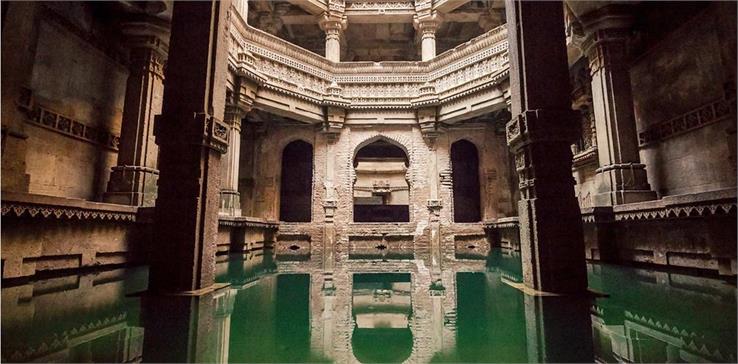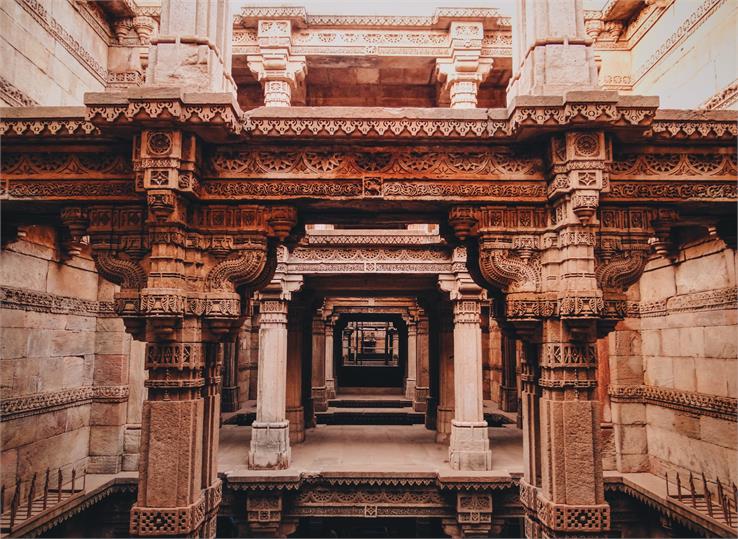The Stepwells of Ahmedabad | The Great Source For Water Reservation In India

Stepwells, also known as Vavs or Baori ( in Gujarati ), are fascinating structures that have existed for centuries. They are wells or ponds with a unique design featuring a long corridor of steps descending to the water level. These stepwells were once used as a water source for drinking, irrigation, and even for people to cool off during hot days. One of the most impressive things about step-wells is their size. Some of the largest stepwells in India can reach depths of up to 30 meters and are capable of holding millions of liters of water.
The intricate designs and carvings found on the steps and walls of these structures are also awe-inspiring and offer a glimpse into the artistic and architectural skills of the people who built them. Although stepwells were once an essential part of daily life in India, many have fallen into disrepair. However, efforts are being made to restore and preserve these unique structures so they can continue to be appreciated for generations. Ahmedabad is home to several stepwells. While the exact number of stepwells in Ahmedabad may vary, numerous well-known and lesser-known stepwells are scattered throughout the city and its surrounding areas. We have compiled a list of some well-known stepwells of Ahmedabad in the below section.
Also Read: Culture and History of India
List of Some Prominent Stepwells of Ahmadabad | Testament To City’s Rich Heritage | Architectural Skills of Ancient People
Some of the prominent stepwells in Ahmedabad include:
1. Adalaj Stepwell
The Adalaj Stepwell, located on the outskirts of Ahmedabad, is a masterpiece of Indo-Islamic architecture. Built-in 1499 by Queen Rudabai in memory of her husband, the stepwell is a five-story structure that descends into the earth with intricate carvings and delicate motifs adorning its walls. The stepwell is a source of water and also a respite from the scorching heat of Gujarat. Its cool, shaded interiors made it a popular gathering place for the local community. The impressive architecture reflects a blend of Indo-Islamic and Hindu styles, making it a unique cultural and historical gem.
Also Read: Famous Shopping Markets of Ahmedabad
2. Dada Harir Stepwell
Dada Harir Stepwell, also known as Dada Hari Vav, is another architectural wonder in Ahmedabad. Built in 1501, this stepwell is renowned for its stunning geometric patterns, beautifully carved pillars, and intricate detailing. It served as a place for social gatherings and a refuge from the heat. The intricate carvings narrate stories from Hindu mythology and showcase the advanced engineering skills of that era. The stepwell's elegant architecture is a testament to the city's rich heritage.
3. Mata Bhavani's Stepwell
Mata Bhavani's Stepwell, situated in the old city of Ahmedabad, is a hidden gem that offers a glimpse into the city's architectural heritage. Built during the Maratha period, this stepwell is known for its spiral staircases and delicate carvings of deities and floral motifs. Its serene ambiance and historical significance make it a peaceful retreat for visitors looking to escape the hustle and bustle of the city.
Also Read: Must Visit Forts and Temples of Madhya Pradesh
4. Asarwa Stepwell
Asarwa Stepwell, also known as 'Asarwa ni Vav,' is an ancient stepwell constructed during the reign of the Chaulukya dynasty. While it may not be as well-known as some other stepwells in Ahmedabad, it possesses its own unique charm. The stepwell features a blend of architectural styles, including Indo-Islamic and Maru-Gurjara architecture elements. Its symmetrical patterns and intricate carvings showcase the artistic prowess of the craftsmen of that era.
5. Amdavad ni Gufa (Ahmedabad's Cave)
While not a traditional stepwell, Amdavad ni Gufa (Ahmedabad's Cave) is an underground art gallery designed by the renowned architect B. V. Doshi. It is located near the famous CEPT University in Ahmedabad. The cave-like structure, with its unique architecture and sculptural designs, offers a contemporary twist on the concept of underground spaces, creating a fascinating juxtaposition with the traditional stepwells of the city.
6. Bai Harir ni Vav
Bai Harir ni Vav is situated in the Asarwa area of Ahmedabad. This stepwell is also known as "Baoli Vav" and is a historical gem in the city. Bai Harir ni Vav is characterized by its intricate and well-preserved architectural details. The stepwell features a stunning series of carved pillars, arches, and chambers that were not only utilitarian but also aesthetically pleasing. It served as a vital source of water for the local community and provided a place for people to gather and socialize.
Also Read: Nalanda Mahavihara The World Heritage Site
7. Bai Harir Stepwell (Bai Harir ni Vav)
Bai Harir ni Vav is located near the Raikhad area of Ahmedabad.
Similar in name but distinct from the previous entry, Bai Harir ni Vav is another historical stepwell in Ahmedabad. It is known for its architectural grandeur and intricate carvings. Like other stepwells in the region, it served the dual purpose of providing water and offering a cool retreat during the sweltering summers. Its historical and architectural significance makes it an intriguing site to explore.
8. Jethabhai's Stepwell
Jethabhai's Stepwell is located in the Asarwa area of Ahmedabad.
This stepwell is a lesser-known gem in Ahmedabad's rich heritage of stepwells. While it may not be as famous as some of the larger and more intricately designed stepwells, it still possesses historical and architectural value. Stepwells like Jethabhai played a crucial role in water conservation and management in the arid region of Gujarat.
9. Kankaria Stepwell (Kankaria ni Vav)
Kankaria Stepwell, also known as Kankaria ni Vav, is near Kankaria Lake in Ahmedabad. Kankaria ni Vav is unique among Ahmedabad's stepwells due to its location near the picturesque Kankaria Lake. It provides a serene atmosphere for visitors. While smaller and ornate than some of the other stepwells, its historical value and connection to the area's water management history make it worth visiting, especially when exploring Kankaria Lake and its surrounding attractions.
10. Rani Ki Vav
Rani Ki Vav is not located in Ahmedabad but in Patan, approximately 124 kilometers from Ahmedabad. Rani Ki Vav, the Queen's Stepwell, is a UNESCO World Heritage Site. Although it is not in Ahmedabad, it's often included in the discussion of stepwells in the region due to its historical and architectural significance. This stepwell is known for its intricate and elaborate carvings, including numerous sculptures, making it one of India's most stunning examples of stepwell architecture. It was constructed by Queen Udayamati in memory of her husband, King Bhimdev I, in the 11th century.
These stepwells, ranging from well-known to lesser-known, collectively showcase the architectural and historical richness of the region, and each has its unique story to tell about water management, communal life, and architectural beauty.
Visiting these stepwells allows us to step back in time, marvel at the intricate craftsmanship, and appreciate the importance of water conservation in a region where water has always been a precious resource.












